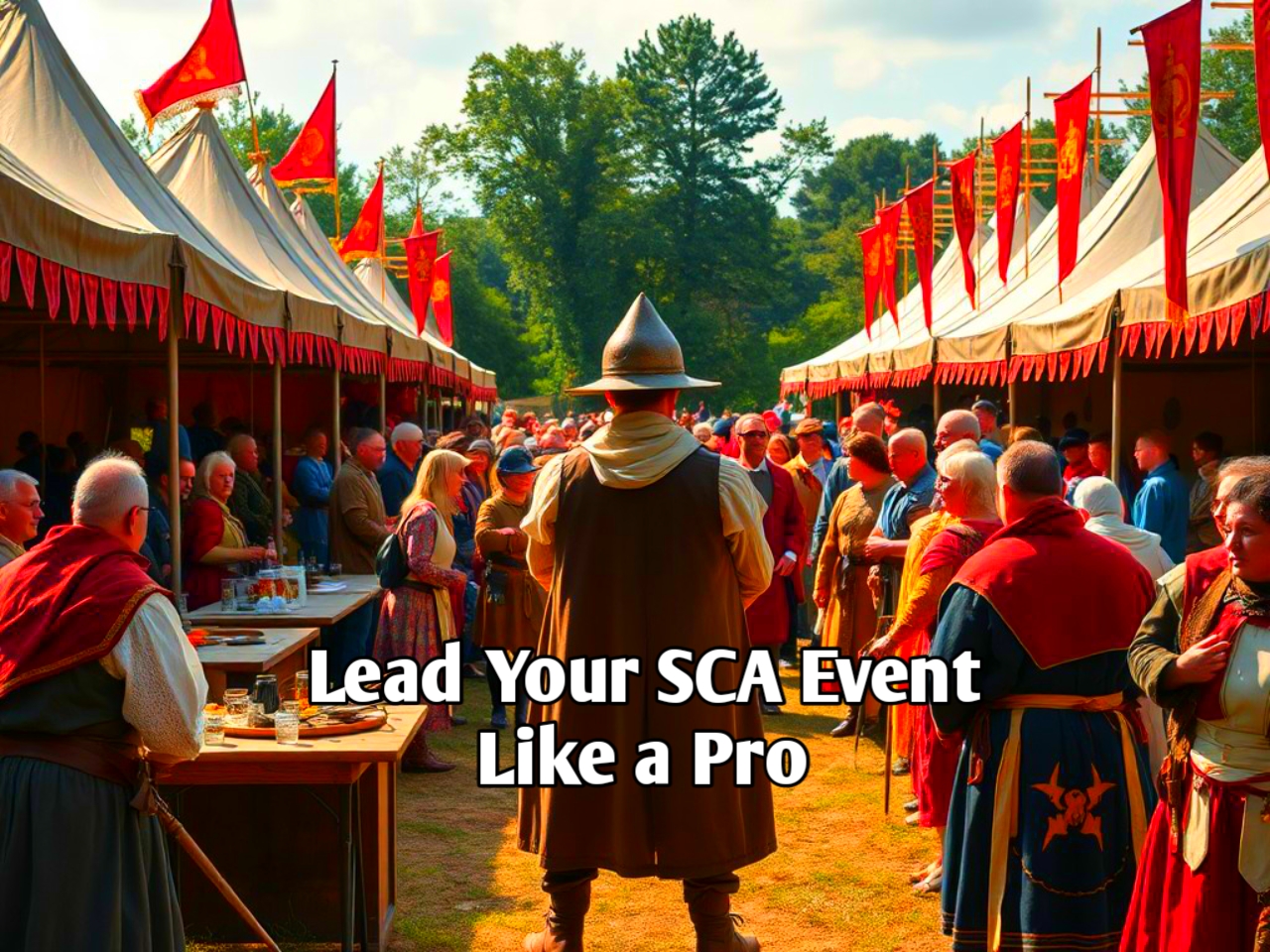How to Autocrat an SCA Event Like a Pro: Planning, Managing, and Execution
Organizing a Society for Creative Anachronism (SCA) event as an autocrat involves both careful planning and precise execution. Whether it’s your first time or you’re looking to improve your event management skills, this guide will help you navigate the process. Autocrating an SCA event means taking on various responsibilities, from budgeting and coordinating volunteers to ensuring an engaging and safe experience for all participants. In this article, we’ll break down the steps and provide helpful insights for running a successful SCA event.
1. Understanding the Role of an Autocrat
The term “autocrat” in the SCA community refers to the lead organizer of an event. Autocrats are responsible for the overall success of the event, handling everything from logistical planning to managing the participant experience. As an autocrat, you’ll coordinate with other members, oversee planning, and make decisions that impact the event’s quality and safety. In essence, you are the director, responsible for ensuring that the event aligns with SCA standards and participant expectations.
Being an autocrat requires a blend of leadership, communication, and organizational skills. You’ll be responsible for many aspects, including:
- Developing and managing the event budget
- Selecting a venue and organizing its setup
- Coordinating volunteers and delegating responsibilities
- Ensuring compliance with SCA and local regulations
- Handling logistics like food, accommodations, and activities
Understanding these roles will prepare you for the multi-faceted nature of autocrating, and knowing the expectations will set you up for success.
2. Setting Clear Goals and Objectives for the Event
The first step in organizing an SCA event is defining what you hope to achieve. Are you planning a small, local gathering or a large-scale regional event? The size and scope of your event will affect everything from budget allocation to the number of volunteers needed. Start by asking these key questions:
- What is the primary purpose of the event? (E.g., competition, education, social gathering)
- What type of atmosphere or experience do you want to create?
- How many people do you expect to attend?
- What will be the main activities or highlights of the event?
Clear goals allow you to create a focused event that meets attendees’ expectations. Make sure to align these objectives with the interests of your target audience and consider any unique SCA traditions that should be incorporated.
3. Building a Team and Delegating Responsibilities
Autocrating an SCA event is not a solo endeavor. Building a reliable team is crucial to handling the various tasks that go into a successful event. Identify key roles, such as:
- Head of Registration – Manages attendee sign-ups, check-ins, and fee collection
- Marshal-in-Charge – Oversees combat-related activities and ensures safety protocols
- Volunteer Coordinator – Recruits and manages volunteers, assigns tasks
- Steward/Logistics Manager – Handles site setup, teardown, and general logistics
- Head of Food and Beverage – Manages meals, refreshments, and catering arrangements
Each of these positions has specific responsibilities, so assign individuals who are both skilled and comfortable with their roles. Clear delegation of duties allows you, as the autocrat, to focus on overall coordination rather than micromanaging each aspect of the event.
4. Budgeting: Planning for Expenses and Income
Setting a realistic budget is a cornerstone of successful event planning. Start by estimating costs in the following categories:
- Venue Rental – This may include fees for both indoor and outdoor spaces.
- Food and Beverage – Include all meals, snacks, and drinks that will be provided.
- Supplies and Decorations – Covers items for site setup, table settings, etc.
- Printing and Promotions – Costs for posters, flyers, and digital marketing.
- Volunteer Expenses – Allocate funds for volunteer needs or small thank-you gifts.
In addition to expenses, consider your sources of income, such as registration fees and potential donations. Make sure your pricing structure covers expenses while remaining affordable. Remember to factor in a contingency fund to account for unexpected costs.
5. Selecting and Securing the Venue
Choosing the right venue is critical to the event’s success. The venue should comfortably accommodate your estimated number of participants and be suited to the type of activities planned. When scouting for a location, consider:
- Capacity and Accessibility – Ensure the space can handle the anticipated crowd.
- Amenities – Look for essential facilities like restrooms, kitchens, and outdoor areas.
- Safety – Ensure that there’s enough room for activities, particularly for combat demonstrations.
- Local Regulations and Permits – Check if the site requires specific permissions.
After selecting a venue, book it as early as possible to avoid scheduling conflicts. Make sure to review the terms and negotiate if necessary, to secure a favorable agreement.
6. Organizing Activities and Scheduling the Day’s Events
A well-structured schedule is essential for smooth event flow. Typically, SCA events include a mix of educational workshops, combat activities, feasts, and social gatherings. Tailor your activities based on the interests of your audience and the goals of your event. Popular activities may include:
- Combat and Archery Demonstrations – Popular at SCA events, these require marshals and safety measures.
- Workshops and Classes – Topics can range from medieval crafts to historical combat techniques.
- Feasts and Refreshments – Plan meals according to tradition, including authentic medieval dishes when possible.
- Social Hours and Gatherings – Allocate time for mingling, as it builds community spirit.
Once activities are planned, create a schedule that allows for breaks and time to transition between events. Publish this schedule in advance and provide printed or digital copies to attendees.
7. Marketing the Event to Attract Participants
Effective promotion ensures a successful turnout. Use both digital and traditional methods to reach your target audience, such as:
- Social Media – Post event details, updates, and visuals on SCA-related groups and pages.
- Email Newsletters – Send out information to local SCA members and interested groups.
- Flyers and Posters – Distribute in local venues and communities interested in medieval culture.
- Word of Mouth – Encourage team members and attendees to spread the word.
Create engaging promotional materials that highlight the unique aspects of the event, such as special guests or rare activities. Early marketing efforts and regular updates help build excitement and awareness, increasing the likelihood of high attendance.
8. Handling Logistics: Equipment, Supplies, and Site Setup
Detailed logistics planning is essential to ensure that everything runs smoothly. Create a checklist for all required items, including:
- Decorations – Keep these historically accurate to enhance the medieval ambiance.
- Audio/Visual Equipment – For announcements, music, or presentations.
- First Aid Supplies – Have basic medical supplies available and trained personnel on standby.
- Signage – Ensure signs direct attendees to various areas like registration, restrooms, and activity zones.
On the day of the event, arrive early to supervise the setup. Check with each team member to ensure that all logistics are in place and ready for participants.
9. Managing Volunteers and Overseeing Event Day Operations
On event day, your role shifts from planning to management. Your focus should be on ensuring everything flows according to the schedule and handling any unexpected challenges. Here are tips for smooth operations:
- Coordinate with Volunteers – Ensure each volunteer understands their tasks and can adapt to changes.
- Stay Accessible – Keep a reliable communication system, such as walkie-talkies or a designated contact point, to address issues quickly.
- Monitor Activities – Walk around to check each area and be available to handle questions or concerns from participants.
- Stay Calm Under Pressure – Problems may arise, but a calm and proactive approach ensures you handle them effectively.
Empowering your team to take ownership of their roles allows you to manage the broader event flow and handle higher-level issues.
10. Wrapping Up: Post-Event Evaluation and Acknowledgments
After the event, take the time to evaluate its success and areas for improvement. Gather feedback from attendees through surveys, and hold a debrief with your team. Key aspects to review include:
- Attendance and Budget – Did you meet your goals for turnout and finances?
- Event Flow and Schedule – Assess whether the timing and activities were effective.
- Team Performance – Recognize contributions and identify opportunities for improvement.
Finally, acknowledge your volunteers, team members, and participants. A simple thank-you note or a post-event email expressing your gratitude reinforces goodwill and makes future recruitment easier.
Organizing an SCA event as an autocrat is a rewarding challenge that requires dedication, teamwork, and attention to detail. With these steps, you’ll be prepared to create a memorable and successful experience for all involved. By balancing thorough preparation with flexibility, you can autocrat an SCA event that meets both the community’s standards and your personal goals as an event organizer.
Read Also Our This Post: Knoxville Nationals 2024: Race Schedule, Top Drivers & Event Info

Kamran Khatri is a versatile writer and editor at ExpressZone.co.uk, bringing fresh perspectives and insightful commentary across a wide range of topics. With a passion for exploring diverse subjects—from technology, business, and finance to lifestyle, travel, and the arts—Kamran aims to inform, inspire, and engage readers through well-researched articles and thought-provoking content.
His work spans multiple categories including health, education, pets, entertainment, real estate, and sustainability, reflecting his commitment to delivering knowledge that connects with everyday life. Whether breaking down the latest trends, sharing practical tips, or highlighting cultural insights, Kamran’s writing combines clarity with creativity.
When he’s not crafting stories for ExpressZone.co.uk, Kamran enjoys keeping up with global developments, exploring innovative ideas, and connecting with readers who share his curiosity about the world.







